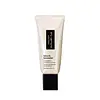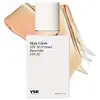Shu Uemura Unlimited Block : Booster Hydrating Primer SPF 50+ PA+++ Versus YSE Beauty Skin Glow SPF 30 Primer
What's inside
What's inside
 Key Ingredients
Key Ingredients

 Benefits
Benefits

 Concerns
Concerns

 Ingredients Side-by-side
Ingredients Side-by-side

Water
Skin ConditioningAlcohol Denat.
AntimicrobialEthylhexyl Salicylate
UV AbsorberIsononyl Isononanoate
EmollientOctocrylene
UV AbsorberButyl Methoxydibenzoylmethane
UV AbsorberEthylhexyl Triazone
UV AbsorberBis-Ethylhexyloxyphenol Methoxyphenyl Triazine
Skin ConditioningCI 77891
Cosmetic ColorantMethylene Bis-Benzotriazolyl Tetramethylbutylphenol
UV FilterPropanediol
SolventIsopropyl Lauroyl Sarcosinate
Skin ConditioningSilica
AbrasiveCetearyl Alcohol
EmollientDiisopropyl Sebacate
EmollientCoco-Caprylate/Caprate
EmollientMica
Cosmetic ColorantPhenoxyethanol
PreservativeHomosalate
Skin ConditioningButylene Glycol
HumectantAmmonium Acryloyldimethyltaurate/Vp Copolymer
Polyglyceryl-10 Laurate
Skin ConditioningCetearyl Glucoside
EmulsifyingTocopherol
AntioxidantGlycerin
HumectantSodium Stearoyl Glutamate
CleansingCaprylyl Glycol
EmollientCaramel
Cosmetic ColorantCarbomer
Emulsion StabilisingInulin Lauryl Carbamate
Emulsion StabilisingTin Oxide
AbrasivePropylene Glycol
HumectantAdenosine
Skin ConditioningTrisodium Ethylenediamine Disuccinate
Xanthan Gum
EmulsifyingAlumina
AbrasiveIsopropyl Titanium Triisostearate
EmollientSorbitol
HumectantZea Mays Kernel Extract
Nelumbo Nucifera Flower Extract
Skin ConditioningCI 17200
Cosmetic ColorantPaeonia Suffruticosa Root Extract
Skin ProtectingSorbic Acid
PreservativeCitric Acid
BufferingWater, Alcohol Denat., Ethylhexyl Salicylate, Isononyl Isononanoate, Octocrylene, Butyl Methoxydibenzoylmethane, Ethylhexyl Triazone, Bis-Ethylhexyloxyphenol Methoxyphenyl Triazine, CI 77891, Methylene Bis-Benzotriazolyl Tetramethylbutylphenol, Propanediol, Isopropyl Lauroyl Sarcosinate, Silica, Cetearyl Alcohol, Diisopropyl Sebacate, Coco-Caprylate/Caprate, Mica, Phenoxyethanol, Homosalate, Butylene Glycol, Ammonium Acryloyldimethyltaurate/Vp Copolymer, Polyglyceryl-10 Laurate, Cetearyl Glucoside, Tocopherol, Glycerin, Sodium Stearoyl Glutamate, Caprylyl Glycol, Caramel, Carbomer, Inulin Lauryl Carbamate, Tin Oxide, Propylene Glycol, Adenosine, Trisodium Ethylenediamine Disuccinate, Xanthan Gum, Alumina, Isopropyl Titanium Triisostearate, Sorbitol, Zea Mays Kernel Extract, Nelumbo Nucifera Flower Extract, CI 17200, Paeonia Suffruticosa Root Extract, Sorbic Acid, Citric Acid
Water
Skin ConditioningPropanediol
SolventButyloctyl Salicylate
Skin ConditioningCetearyl Alcohol
EmollientPolymethylsilsesquioxane
Dimethicone
EmollientDicaprylyl Carbonate
EmollientCI 77163
Cosmetic ColorantGlyceryl Stearate
EmollientJojoba Esters
EmollientSodium Stearoyl Glutamate
CleansingPhenoxyethanol
PreservativeDimethicone Crosspolymer
Emulsion StabilisingMica
Cosmetic ColorantEthylhexyl Hydroxystearate
EmollientXanthan Gum
EmulsifyingIron Oxides
Helianthus Annuus Seed Wax
Skin ConditioningOryza Sativa Bran Extract
Skin ConditioningChlorphenesin
AntimicrobialAcrylates/C10-30 Alkyl Acrylate Crosspolymer
Emulsion StabilisingCaprylyl Glycol
EmollientNiacinamide
SmoothingCI 77891
Cosmetic ColorantEthylhexylglycerin
Skin ConditioningHexylene Glycol
EmulsifyingStearyl Glycyrrhetinate
Skin ConditioningTetrasodium Glutamate Diacetate
Helianthus Annuus Extract
EmollientSucrose
HumectantGlycyrrhiza Glabra Root Extract
BleachingSodium Hydroxide
BufferingPolyglycerin-3
HumectantTocopherol
AntioxidantRosmarinus Officinalis Leaf Extract
AntimicrobialSpirulina Maxima Extract
SmoothingSodium Hyaluronate
HumectantLecithin
EmollientButyl Methoxydibenzoylmethane
UV AbsorberHomosalate
Skin ConditioningEthylhexyl Salicylate
UV AbsorberOctocrylene
UV AbsorberWater, Propanediol, Butyloctyl Salicylate, Cetearyl Alcohol, Polymethylsilsesquioxane, Dimethicone, Dicaprylyl Carbonate, CI 77163, Glyceryl Stearate, Jojoba Esters, Sodium Stearoyl Glutamate, Phenoxyethanol, Dimethicone Crosspolymer, Mica, Ethylhexyl Hydroxystearate, Xanthan Gum, Iron Oxides, Helianthus Annuus Seed Wax, Oryza Sativa Bran Extract, Chlorphenesin, Acrylates/C10-30 Alkyl Acrylate Crosspolymer, Caprylyl Glycol, Niacinamide, CI 77891, Ethylhexylglycerin, Hexylene Glycol, Stearyl Glycyrrhetinate, Tetrasodium Glutamate Diacetate, Helianthus Annuus Extract, Sucrose, Glycyrrhiza Glabra Root Extract, Sodium Hydroxide, Polyglycerin-3, Tocopherol, Rosmarinus Officinalis Leaf Extract, Spirulina Maxima Extract, Sodium Hyaluronate, Lecithin, Butyl Methoxydibenzoylmethane, Homosalate, Ethylhexyl Salicylate, Octocrylene
Ingredients Explained
These ingredients are found in both products.
Ingredients higher up in an ingredient list are typically present in a larger amount.
Also known as Avobenzone, this ingredient is a chemical sunscreen filter that provides protection in the UV-A range.
Avobenzone is globally approved and is the most commonly used UV-A filter in the world.
Studies have found that avobenzone becomes ineffective when exposed to UV light (it is not photostable; meaning that it breaks down in sunlight). Because of this, formulations that include avobenzone will usually contain stabilizers such as octocrylene.
However, some modern formulations (looking at you, EU!) are able to stabilize avobenzone by coating the molecules.
Avobenzone does not protect against the UV-B range, so it's important to check that the sunscreen you're using contains other UV filters that do!
The highest concentration of avobenzone permitted is 3% in the US, and 5% in the EU.
Learn more about Butyl MethoxydibenzoylmethaneCaprylyl Glycol is a humectant and emollient, meaning it attracts and preserves moisture.
It is a common ingredient in many products, especially those designed to hydrate skin. The primary benefits are retaining moisture, skin softening, and promoting a healthy skin barrier.
Though Caprylyl Glycol is an alcohol derived from fatty acids, it is not the kind that can dry out skin.
This ingredient is also used as a preservative to extend the life of products. It has slight antimicrobial properties.
Learn more about Caprylyl GlycolCetearyl alcohol is a mixture of two fatty alcohols: cetyl alcohol and stearyl alcohol. It is mainly used as an emulsifier. Emulsifiers help prevent the separation of oils and products. Due to its composition, it can also be used to thicken a product or help create foam.
Cetearyl alcohol is an emollient. Emollients help soothe and hydrate the skin by trapping moisture.
Studies show Cetearyl alcohol is non-toxic and non-irritating. The FDA allows products labeled "alcohol-free" to have fatty alcohols.
This ingredient is usually derived from plant oils such as palm, vegetable, or coconut oils. There is debate on whether this ingredient will cause acne.
Due to the fatty acid base, this ingredient may not be Malassezia folliculitis safe.
Learn more about Cetearyl AlcoholCi 77891 is a white pigment from Titanium dioxide. It is naturally found in minerals such as rutile and ilmenite.
It's main function is to add a white color to cosmetics. It can also be mixed with other colors to create different shades.
Ci 77891 is commonly found in sunscreens due to its ability to block UV rays.
Learn more about CI 77891Ethylhexyl Salicylate is an organic compound used to block UV rays. It primarily absorbs UVB rays but offers a small amount of UVA protection as well.
Commonly found in sunscreens, Ethylhexyl Salicylate is created from salicylic acid and 2-ethylhexanol. You might know salicylic acid as the effective acne fighter ingredient and BHA.
The ethylhexanol in this ingredient is a fatty alcohol and helps hydrate your skin, similar to oils. It is an emollient, which means it traps moisture into the skin.
According to manufacturers, Ethylhexyl Salicylate absorbs UV wavelength of 295-315 nm, with a peak absorption at 307-310 nm. UVA rays are linked to long term skin damage, such as hyperpigmentation. UVB rays emit more energy and are capable of damaging our DNA. UVB rays cause sunburn.
Learn more about Ethylhexyl SalicylateHomosalate is a chemical sunscreen filter that provides protection in the UV-B range (280nm - 320 nm), with a peak protection at 306 nm. It is internationally approved for use in sunscreens.
Homosalate is not photo-stable, meaning it's strength as a UV filter degrades over time with exposure to the sun. Because of this, it's often used in combination with other chemical sunscreen filters as avobenzone (which protects from the UV-A range). Homosalate also helps act as a solvent for harder-to-dissolve UV filters.
(Part of the reason that sunscreens need to be frequently re-applied is due to the photo instability of many chemical sunscreen filters)
Currently, homosalate is approved in concentrations up to 10% in the EU and 15% in the US. The FDA is currently doing further research on the effects of homosalate, and it is possible that these approved concentrations will change in the future.
Learn more about HomosalateMica is a naturally occurring mineral used to add shimmer and color in cosmetics. It can also help improve the texture of a product or give it an opaque, white/silver color.
Serecite is the name for very fine but ragged grains of mica.
This ingredient is often coated with metal oxides like titanium dioxide. Trace amounts of heavy metals may be found in mica, but these metals are not harmful in our personal products.
Mica has been used since prehistoric times throughout the world. Ancient Egyptian, Indian, Greek, Roman, Aztec, and Chinese civilizations have used mica.
Learn more about MicaOctocrylene protects skin from sun damage. It absorbs UV-B with peak absorption of 304 nm. It is a common sunscreen ingredient and often paired with avobenzone, a UVA filter. This is because octocrylene stabilizes other sunscreen ingredients by protecting them from degradation when exposed to sunlight. Octocrylene is a photostable ingredient and loses about 10% of SPF in 95 minutes.
Octocrylene also acts as an emollient, meaning it helps skin retain moisture and softens skin. It is oil-soluble and hydrophobic, enhancing water-resistant properties in a product.
Those who are using ketoprofen, a topical anti-inflammatory drug, may experience an allergic reaction when using octocrylene. It is best to speak with a healthcare professional about using sunscreens with octocrylene.
The EU allows a maximum of these concentrations:
Learn more about OctocrylenePhenoxyethanol is a preservative that has germicide, antimicrobial, and aromatic properties. Studies show that phenoxyethanol can prevent microbial growth. By itself, it has a scent that is similar to that of a rose.
It's often used in formulations along with Caprylyl Glycol to preserve the shelf life of products.
Propanediol is an all-star ingredient. It softens, hydrates, and smooths the skin.
It’s often used to:
Propanediol is not likely to cause sensitivity and considered safe to use. It is derived from corn or petroleum with a clear color and no scent.
Learn more about PropanediolSodium Stearoyl Glutamate is an emulsifier and helps condition the skin. It is amino acid-based.
In higher amounts, it may act as a cleansing agent.
Tocopherol (also known as Vitamin E) is a common antioxidant used to help protect the skin from free-radicals and strengthen the skin barrier. It's also fat soluble - this means our skin is great at absorbing it.
Vitamin E also helps keep your natural skin lipids healthy. Your lipid skin barrier naturally consists of lipids, ceramides, and fatty acids. Vitamin E offers extra protection for your skin’s lipid barrier, keeping your skin healthy and nourished.
Another benefit is a bit of UV protection. Vitamin E helps reduce the damage caused by UVB rays. (It should not replace your sunscreen). Combining it with Vitamin C can decrease sunburned cells and hyperpigmentation after UV exposure.
You might have noticed Vitamin E + C often paired together. This is because it is great at stabilizing Vitamin C. Using the two together helps increase the effectiveness of both ingredients.
There are often claims that Vitamin E can reduce/prevent scarring, but these claims haven't been confirmed by scientific research.
Learn more about TocopherolWater. It's the most common cosmetic ingredient of all. You'll usually see it at the top of ingredient lists, meaning that it makes up the largest part of the product.
So why is it so popular? Water most often acts as a solvent - this means that it helps dissolve other ingredients into the formulation.
You'll also recognize water as that liquid we all need to stay alive. If you see this, drink a glass of water. Stay hydrated!
Learn more about WaterXanthan gum is used as a stabilizer and thickener within cosmetic products. It helps give products a sticky, thick feeling - preventing them from being too runny.
On the technical side of things, xanthan gum is a polysaccharide - a combination consisting of multiple sugar molecules bonded together.
Xanthan gum is a pretty common and great ingredient. It is a natural, non-toxic, non-irritating ingredient that is also commonly used in food products.
Learn more about Xanthan Gum